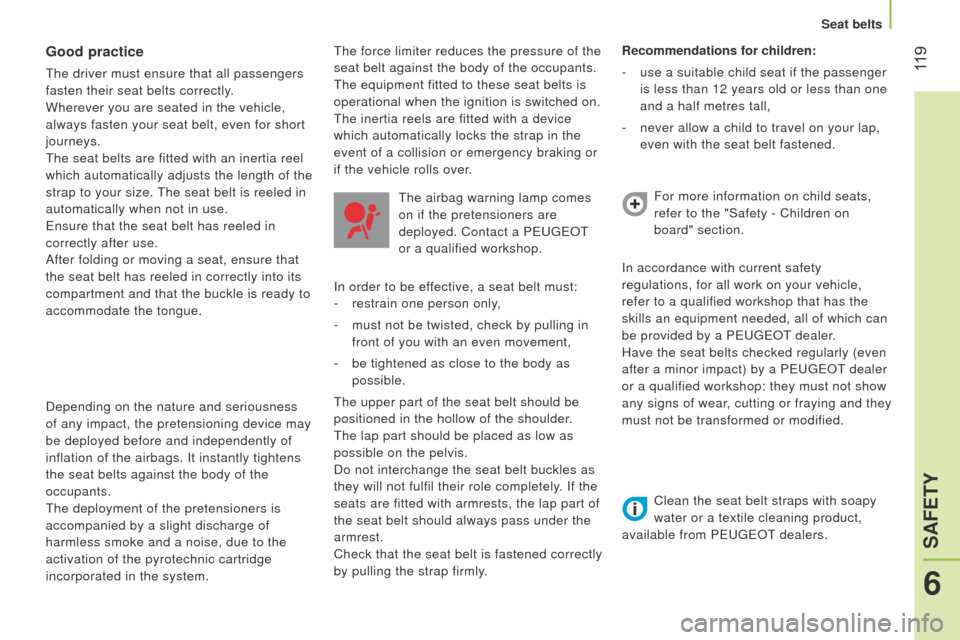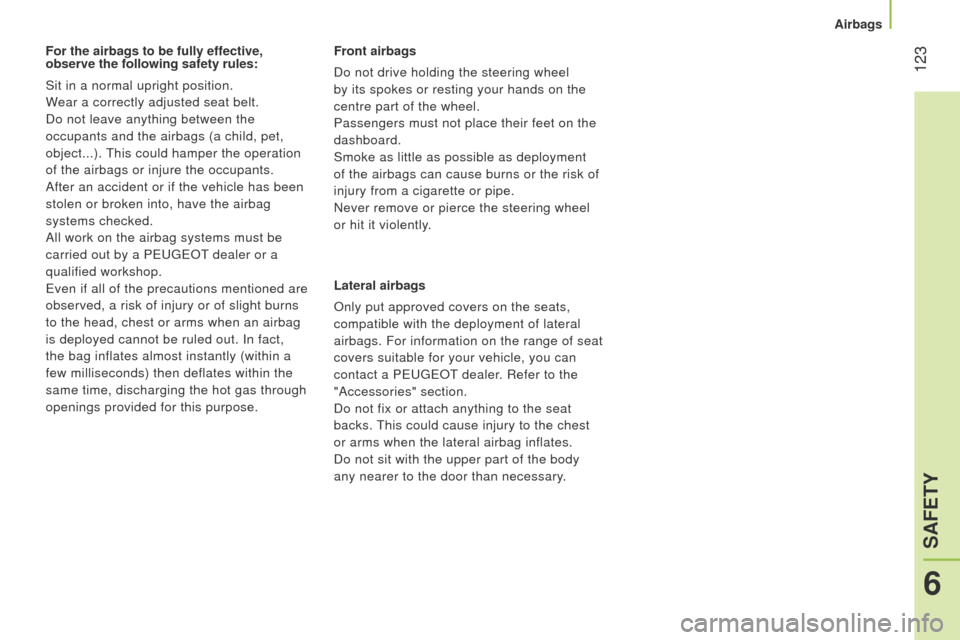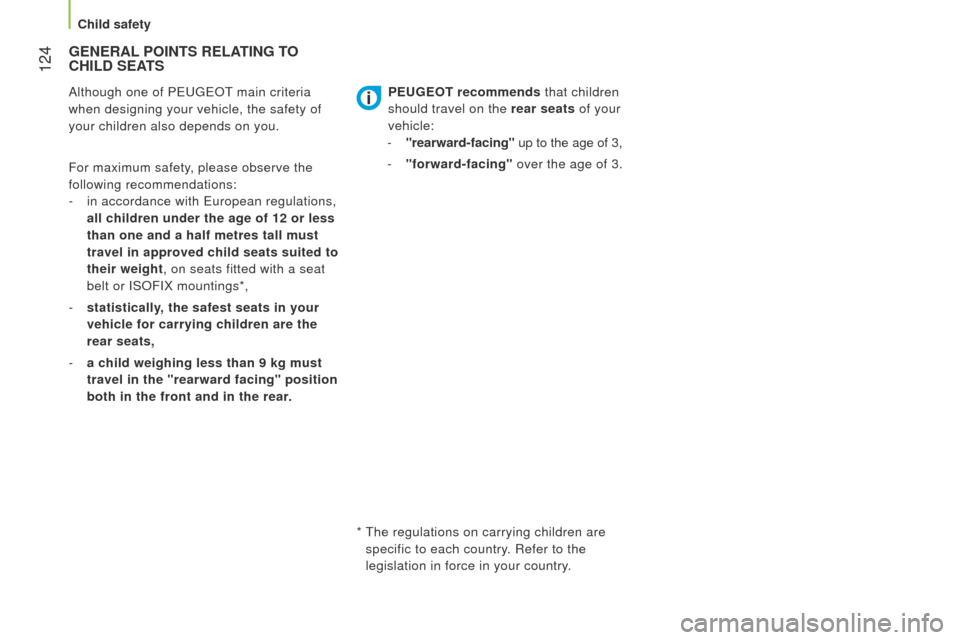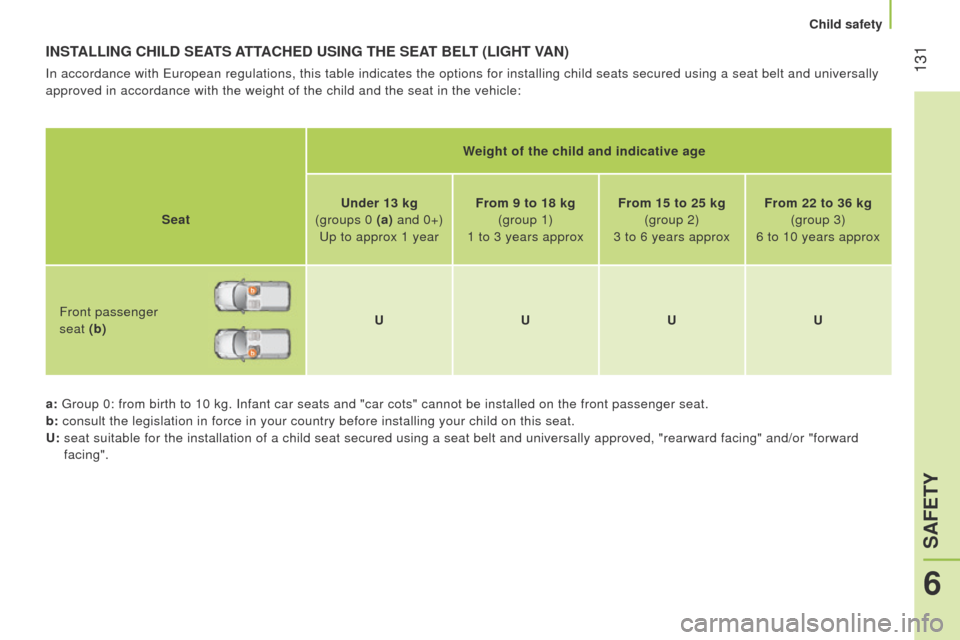Page 120 of 192

11 8
Bipper_en_Chap06_securite_ed02-2014
FRONT SEAT BELTS
the front seats are fitted with pre-tensioners
and force limiters.
Fastening
Pull the strap, then insert the tongue into the
buckle.
Check that the seat belt is fastened correctly
by pulling the strap.
t
he lap belt must be positioned as low as
possible on the pelvis.
t
he chest belt must
pass over the hollow of the shoulder.
Inertia reel seat belts
these are fitted with a device which locks
automatically in the event of a collision or
emergency braking.
Safety in the event of a front impact has
been improved by the introduction of
pretensioning and force limiting seat belts.
Depending on the seriousness of the
impact, the pretensioning system instantly
tightens the seat belt against the body of the
occupant.
t
he pretensioning seat belts are active when
the ignition is on.
t
he force limiter reduces the pressure of the
seat belt against the body of the occupant in
the event of an accident.
Driver's seat belt not fastened warning
lamp
When the vehicle is started, this
warning lamp comes on if the
driver has not fastened their seat
belt.
REAR SEAT BELTS (COMBI)
the 3-seat bench is fitted with three-point
inertia reel seat belts with force limiter .
t
he centre seat has a seat belt guide and
inertia reel, integrated with the seat back.
When a seat belt is not in use, you can
store its buckle in the housing provided
in the bench seat cushion.
If the driver's seat belt is unfastened,
the S
t
ARt mode of Stop & Start will
not be invoked.
t
he engine can only be
restarted using the ignition key.
Seat belts
Page 121 of 192

11 9
Bipper_en_Chap06_securite_ed02-2014
Good practice
the driver must ensure that all passengers
fasten their seat belts correctly .
Wherever you are seated in the vehicle,
always fasten your seat belt, even for short
journeys.
t
he seat belts are fitted with an inertia reel
which automatically adjusts the length of the
strap to your size.
t
he seat belt is reeled in
automatically when not in use.
e
nsure that the seat belt has reeled in
correctly after use.
After folding or moving a seat, ensure that
the seat belt has reeled in correctly into its
compartment and that the buckle is ready to
accommodate the tongue.
t
he force limiter reduces the pressure of the
seat belt against the body of the occupants. t he equipment fitted to these seat belts is
operational when the ignition is switched on.
t
he inertia reels are fitted with a device
which automatically locks the strap in the
event of a collision or emergency braking or
if the vehicle rolls over.
t
he airbag warning lamp comes
on if the pretensioners are
deployed. Contact a P
euge O t
or a qualified workshop.
Depending on the nature and seriousness
of any impact, the pretensioning device may
be deployed before and independently of
inflation of the airbags. It instantly tightens
the seat belts against the body of the
occupants.
t
he deployment of the pretensioners is
accompanied by a slight discharge of
harmless smoke and a noise, due to the
activation of the pyrotechnic cartridge
incorporated in the system. In order to be effective, a seat belt must:
-
restrain one person only
,
-
must not be twisted, check by pulling in
front of you with an even movement,
-
be tightened as close to the body as
possible.
t
he upper part of the seat belt should be
positioned in the hollow of the shoulder.
t
he lap part should be placed as low as
possible on the pelvis.
Do not interchange the seat belt buckles as
they will not fulfil their role completely. If the
seats are fitted with armrests, the lap part of
the seat belt should always pass under the
armrest.
Check that the seat belt is fastened correctly
by pulling the strap firmly. Recommendations for children:
-
use a suitable child seat if the passenger
is less than 12 years old or less than one
and a half metres tall,
-
never allow a child to travel on your lap,
even with the seat belt fastened.
For more information on child seats,
refer to the "Safety - Children on
board" section.
In accordance with current safety
regulations, for all work on your vehicle,
refer to a qualified workshop that has the
skills an equipment needed, all of which can
be provided by a P
euge O t
dealer
.
Have the seat belts checked regularly (even
after a minor impact) by a P
euge O t
dealer
or a qualified workshop: they must not show
any signs of wear, cutting or fraying and they
must not be transformed or modified.
Clean the seat belt straps with soapy
water or a textile cleaning product,
available from P
euge O t
dealers.
6
SAFETY
Seat belts
Page 125 of 192

123
Bipper_en_Chap06_securite_ed02-2014
For the airbags to be fully effective,
observe the following safety rules:
Sit in a normal upright position.
Wear a correctly adjusted seat belt.
Do not leave anything between the
occupants and the airbags (a child, pet,
object...).
t
his could hamper the operation
of the airbags or injure the occupants.
After an accident or if the vehicle has been
stolen or broken into, have the airbag
systems checked.
All work on the airbag systems must be
carried out by a P
euge O t
dealer or a
qualified workshop.
e
ven if all of the precautions mentioned are
observed, a risk of injury or of slight burns
to the head, chest or arms when an airbag
is deployed cannot be ruled out. In fact,
the bag inflates almost instantly (within a
few milliseconds) then deflates within the
same time, discharging the hot gas through
openings provided for this purpose. Front airbags
Do not drive holding the steering wheel
by its spokes or resting your hands on the
centre part of the wheel.
Passengers must not place their feet on the
dashboard.
Smoke as little as possible as deployment
of the airbags can cause burns or the risk of
injury from a cigarette or pipe.
Never remove or pierce the steering wheel
or hit it violently.
Lateral airbags
Only put approved covers on the seats,
compatible with the deployment of lateral
airbags. For information on the range of seat
covers suitable for your vehicle, you can
contact a P
euge O t
dealer
. Refer to the
"Accessories" section.
Do not fix or attach anything to the seat
backs.
t
his could cause injury to the chest
or arms when the lateral airbag inflates.
Do not sit with the upper part of the body
any nearer to the door than necessary.
6
SAFETY
Airbags
Page 126 of 192

124
Bipper_en_Chap06_securite_ed02-2014
GENERAL POINTS RELATING TO CHILD
SEATS
Although one of PeugeOt main criteria
when designing your vehicle, the safety of
your children also depends on you.
*
t he regulations on carrying children are
specific to each country. Refer to the
legislation in force in your country.
For maximum safety, please observe the
following recommendations:
-
in accordance with
e uropean regulations,
all children under the age of 12 or less
than one and a half metres tall must
travel in approved child seats suited to
their weight, on seats fitted with a seat
belt or ISOFIX mountings*,
-
statistically
, the safest seats in your
vehicle for carrying children are the
rear seats,
-
a child weighing less than 9 kg must
travel in the "rearward facing" position
both in the front and in the rear. PEUGEOT recommends that children
should travel on the rear seats of your
vehicle:
-
"rearward-facing"
up to the age of 3,
-
"forward-facing"
over the age of 3.
Child safety
Page 127 of 192
125
Bipper_en_Chap06_securite_ed02-2014
CHILD SEAT AT THE REAR (C OMBI )
"Rearward facing"
When a "rearward facing" child
seat is installed on a rear
passenger seat, move the
vehicle's front seat forwards
and straighten the backrest so that the
"rearward facing" child seat does not touch
the vehicle's front seat.
"Forward facing"
When a "forward facing" child
seat is installed on a rear
passenger seat, move the
vehicle's front seat forwards
and straighten the backrest so that the legs
of the child in the "forward facing" child seat
do not touch the vehicle's front seat.
e
nsure that the seat belt is correctly
tightened. For child seats with a
support leg, ensure that the support leg is in
stable contact with the floor.
6
SAFETY
Child safety
Page 128 of 192
126
Bipper_en_Chap06_securite_ed02-2014
CHILD SEAT IN THE FRONT*
"Rearward-facing"
When a "rearward-facing" child
seat is installed on the front
passenger seat, adjust the seat
to the intermediate longitudinal
and highest position, with the backrest
straightened.
t
he passenger airbag must be deactivated.
Otherwise, the child would risk being
seriously injured or killed if the airbag
were to inflate.
*
Refer to the current legislation in your
country before installing a child seat on
this seat.
"Forward-facing"
When a "forward-facing" child
seat is installed on the front
passenger seat, adjust the
vehicle's seat to the intermediate
longitudinal and highest position with
seat backrest straightened and leave the
passenger's airbag activated.
e
nsure that the seat belt is correctly
tensioned.
For child seats with a support leg, ensure
that the support leg is in stable contact with
the floor. If necessary, adjust the passenger
seat.
Child safety
Page 132 of 192
130
Bipper_en_Chap06_securite_ed02-2014
CHILD SEATS RECOMMENDED BY PEUGEOT
PeugeOt offers a range of recommended child seats which are secured using a three
point seat belt.
Group 0+: from birth to 13 kg
L1
"RÖM
e R Baby-Safe Plus"
Installed in the rearward facing position.
Groups 2 and 3: from 15 to 36 kg L4
"K
l IPPAN Optima"
From 22 kg (approximately 6 years), the booster is used on its own.
L5
"RÖM
e R KIDFIX"
Can be fitted to the vehicle's ISOFIX mountings.
t
he child is restrained by the seat belt.
Child safety
Page 133 of 192

131
Bipper_en_Chap06_securite_ed02-2014
INSTALLING CHILD SEATS ATTACHED USING THE SEAT BELT (LIGHT VAN)
In accordance with european regulations, this table indicates the options for installing chi\
ld seats secured using a seat belt and universally
approved in accordance with the weight of the child and the seat in the \
vehicle:
W
eight of the child and indicative age
Seat Under 13 kg
(groups 0 (a) and 0+)
u
p to approx 1 yearFrom 9 to 18 kg
(group 1)
1 to 3 years approx From 15 to 25 kg
(group 2)
3 to 6 years approx From 22 to 36 kg
(group 3)
6 to 10 years approx
Front passenger
seat (b) U
UUU
a :
g roup 0: from birth to 10 kg. Infant car seats and "car cots" cannot be i\
nstalled on the front passenger seat.
b : consult the legislation in force in your country before installing your\
child on this seat.
U:
seat suitable for the installation of a child seat secured using a seat \
belt and universally approved, "rearward facing" and/or
"forward
facing".
6
SAFETY
Child safety